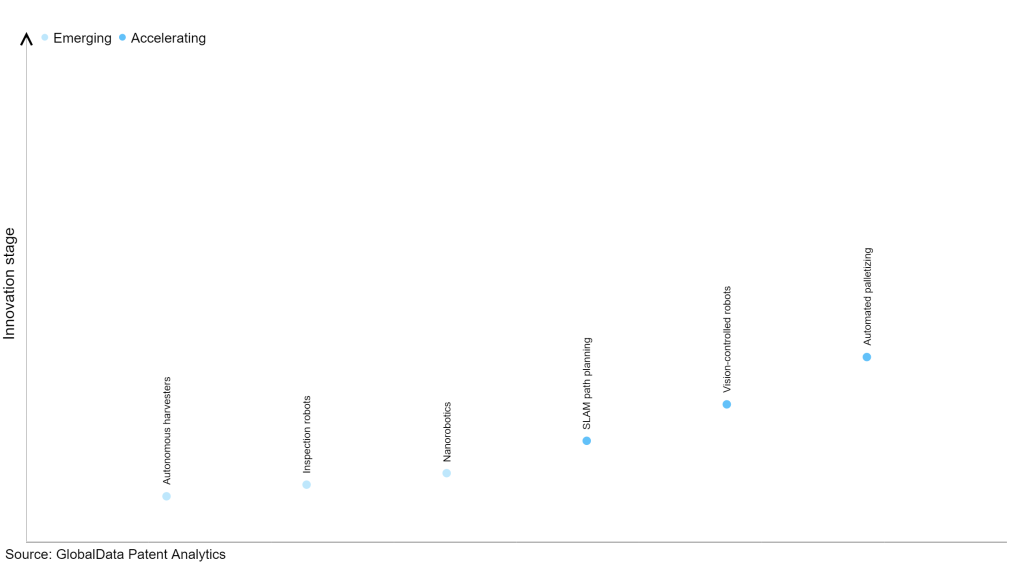The technology industry continues to be a of patent innovation. Activity is driven by advancements in robotics. Developments in sensors, machine learning, and artificial intelligence have enabled the creation of robots that possess enhanced capabilities and versatility. The growing importance of technologies such as cameras and sensors, communication systems, autonomous navigation, and data storage and processing further supports innovation in this industry. These technologies work together to enhance the surveillance capabilities of robots, enabling them to capture, analyze, and transmit data, navigate autonomously, and perform effective monitoring tasks in various environments. By utilizing a combination of advanced technologies, surveillance robots contribute to improved situational awareness, enhanced security, and efficient monitoring and surveillance operations. In the last three years alone, there have been over 1.5 million patents filed and granted in the technology industry, according to GlobalData’s report on Robotics in technology: surveillance robots. Buy the report here.

Access deeper industry intelligence
Experience unmatched clarity with a single platform that combines unique data, AI, and human expertise.
However, not all innovations are equal and nor do they follow a constant upward trend. Instead, their evolution takes the form of an S-shaped curve that reflects their typical lifecycle from early emergence to accelerating adoption, before finally stabilizing and reaching maturity.
Identifying where a particular innovation is on this journey, especially those that are in the emerging and accelerating stages, is essential for understanding their current level of adoption and the likely future trajectory and impact they will have.
185+ innovations will shape the technology industry
According to GlobalData’s Technology Foresights, which plots the S-curve for the technology industry using innovation intensity models built on over 1.5 million patents, there are 185+ innovation areas that will shape the future of the industry.
Within the emerging innovation stage, autonomous harvesters, inspection robots and nanorobotics are disruptive technologies that are in the early stages of application and should be tracked closely. SLAM path planning, vision-controlled robots, and automated palletizing are some of the accelerating innovation areas, where adoption has been steadily increasing.
Innovation S-curve for robotics in the technology industry

Surveillance robots is a key innovation area in robotics
Surveillance robots are robotic devices employed to observe and collect information within specific areas or environments. Their primary applications include security, surveillance, and reconnaissance. Along with tracking and navigation systems that facilitate their movement throughout the monitored area, these robots are equipped with sensors and cameras to detect and document activities. .
GlobalData’s analysis also uncovers the companies at the forefront of each innovation area and assesses the potential reach and impact of their patenting activity across different applications and geographies. According to GlobalData, there are 210+ companies, spanning technology vendors, established technology companies, and up-and-coming start-ups engaged in the development and application of surveillance robots.
Key players in surveillance robots – a disruptive innovation in the technology industry
‘Application diversity’ measures the number of applications identified for each patent. It broadly splits companies into either ‘niche’ or ‘diversified’ innovators.
‘Geographic reach’ refers to the number of countries each patent is registered in. It reflects the breadth of geographic application intended, ranging from ‘global’ to ‘local’.
NEC is the leading patent filer in the surveillance robots space. One of the company’s patents describes a face recognition system that captures a video sequence of unlabeled testing video frames. The system pre-trains a face recognition engine using labelled training still image frames of faces and adapts it to the video domain by incorporating non-reference convolutional neural networks (CNNs). The adapted engine is then used to recognize and display the identities of persons corresponding to faces in the video sequence.
Other prominent patent filers in the space include Alphabet, Panasonic, and Sony Group.
In terms of geographical reach, Q-Bot leads the pack, followed by ATSR and Trax Technology Solutions. In terms of application diversity, ATSR holds the top position, followed by NEC and Q-Bot.
Surveillance robots offer significant advantages in terms of enhanced security, remote monitoring, improved situational awareness, cost-effectiveness, and swift response capabilities. By leveraging these robots, organizations can bolster their surveillance measures, mitigate risks, and maintain a safer and more secure environment.
To further understand how robotics is disrupting the technology industry, access GlobalData’s latest thematic research report on Robotics.
Data Insights
From

The gold standard of business intelligence.
Blending expert knowledge with cutting-edge technology, GlobalData’s unrivalled proprietary data will enable you to decode what’s happening in your market. You can make better informed decisions and gain a future-proof advantage over your competitors.







